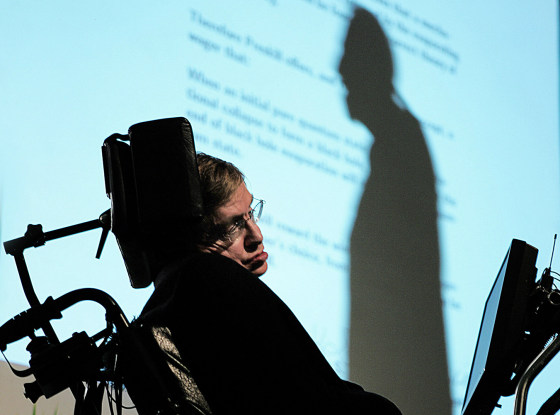After 29 years of thinking about it, Stephen Hawking says he was wrong about black holes.
The renowned Cambridge University physicist formally presented a paper Wednesday arguing that black holes, the celestial vortexes formed from collapsed stars, preserve traces of objects swallowed up and eventually could spit bits out “in a mangled form.” Last week, in an interview with the British Broadcasting Corp., he revealed he had changed his long-held thinking on black holes.
Hawking’s radical new theory caps his three-decade struggle to explain a paradox in scientific thinking: How can objects really “disappear” inside a black hole and leave no trace, as he long believed, when subatomic theory says matter can be transformed but never fully destroyed?
Hawking had previously insisted that black holes destroy all molecular fingerprints of their contents and emit only a generic form of radiation.
But on Wednesday at the 17th International Conference on General Relativity and Gravitation, Hawking presented mind-boggling new calculations that suggest black holes are able to cast out their contents — and that there’s only one way in and one way out.
Theoretical reversal
Hawking, 62, said he no longer believes a 1980s theory that black holes might offer passage into another universe, a rival explanation for identifying where matter and energy go when consumed by a black hole.
Hawking now sides with particle physicists who have long insisted that any matter swallowed by a black hole can’t just disappear but must eventually generate a specific output. The latest theory offers hope that scientists one day may identify the history of what a black hole has taken in over the eons — by decoding what it emits.
“There is no baby universe branching off (inside a black hole), as I once thought. The information remains firmly in our universe,” Hawking said in a speech to about 800 physicists and other scientists from 50 countries. “I’m sorry to disappoint science fiction fans, but if information is preserved, there is no possibility of using black holes to travel to other universes.
“If you jump into a black hole, your mass energy will be returned to our universe, but in a mangled form, which contains the information about what you were like, but in an unrecognizable state.”
Skepticism and puzzlement
Hawking’s new theory produced waves of skepticism and puzzlement from leading physics professors. Two in the front row — William Unruh of the University of British Columbia and Robert Wald of the University of Chicago — shrugged and shook their heads in disbelief as Hawking spoke.
“Hawking is completely revising his prior belief that what goes into a black hole is washed out. Now he believes that anything emitted from a black hole can be identifiable back to its source,” said Wald, an expert on black holes. “He’s running away from what we still believe.”
Unruh said: “Part of the problem is he’s providing so few details, so it’s impossible to know whether we can believe these calculations. Stephen Hawking’s not stupid, so we’re going to take what he says seriously ... but the whole theory we’re hearing seems extremely speculative.”
Settling a bet
Not long ago, Hawking was just as certain that black holes destroyed whatever they took in.
In 1997, he and Caltech physics professor Kip Thorne made a well-publicized bet with a particle physicist, John Preskill, that “information swallowed by a black hole is forever hidden from the outside universe and can never be revealed, even as the black hole evaporates and completely disappears.”
Preskill, also a Caltech professor, insisted that information on a black hole’s consumption “must and will be found in the correct theory of quantum gravity.”
On Wednesday, Hawking ended his lecture by saying he had proved that Preskill was right after all. Preskill received an encyclopedia on baseball as his reward.
Preskill said he was pleased to have won the bet with so many witnesses present, but was sad too. “It’s been so much fun talking about this issue for such a long time. What are we going to argue about now?” he said to laughter.
Preskill said he was looking forward to seeing Hawking’s much more detailed paper on the subject next month. “I’ll be honest — I didn’t understand the talk,” he said.
International fame
Hawking shot to international fame in 1988 with his best-selling book “A Brief History of Time,” which sought to explain to a general audience the most complex aspects of the universe.
He had already been famous in physics circles since the mid-1970s, when he postulated that black holes could eventually evaporate and disappear, emitting radiation as they die. That radiation has been named “Hawking radiation” in his honor.
Despite being virtually paralyzed and wheelchair-bound with amyotrophic lateral sclerosis since his mid-20s, Hawking travels the world on speaking engagements. He communicates by using a hand-held device to select words on his wheelchair’s computer screen.
The slow process of constructing answers Wednesday meant Hawking could answer only two questions in the half-hour news conference that followed his lecture. The final questioner asked what problem he planned to tackle next, now that the paradox of the black hole was out of the way.
“I don’t know,” Hawking quickly replied, bringing the house down with laughter.
